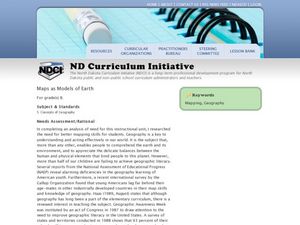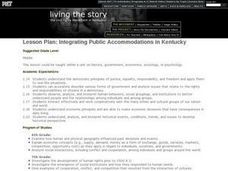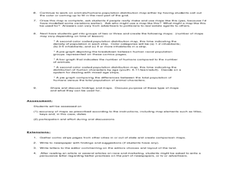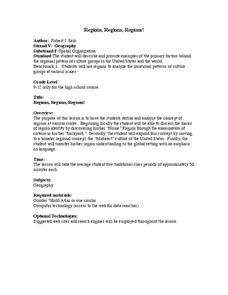Curated OER
The Bread of the Sandwich
Students create relief maps of Canada and Mexico out of everyday objects like dried macaroni, dry rice, sand, etc. They create a clue card for a location game and try to stump their classmates. They host a travel fair to display their...
Curated OER
At Home on the Range
Eighth graders explore rangeland uses in Utah. In this Utah rangeland lesson, 8th graders read background information on the purposes of rangeland. Students work in groups to create their own ranges using peat. Students discover grazing...
Curated OER
URBAN WILDERNESS AND PARKS
Student examine the need for and the problems of wilderness areas which are located close to urban centers. They discuss their concept of wilderness, write down their perceptions and report to the class.
Curated OER
Maps as Models of Earth
Eighth graders use different types of maps to find locations and surface features. For this map-reading lesson students use a compass to find direction.
Curated OER
Leaving Home for the West - Why?
Students examine primary sources regarding American movement to the west. In this westward expansion lesson, students create broadside posters based on the Homestead Act primary sources they research.
Curated OER
Guardians of the West
Eighth graders discover the role of American buffalo in Westward Expansion. In this Westward Expansion lesson, 8th graders examine primary and secondary sources in order to create a cause and effect chart that features the treatment of...
Curated OER
Because We Can, Should We?
Young scholars identify a position on an issue of geographic importance and support it They read the story "By the Waters of Babylon," and write a paragraph explaining what they think the relationship between Babylon and the Biblical...
Curated OER
The Oregon Trail
Students discuss migration and reasons people came across the Oregon trail. Students create a time line of important events along the Oregon trail. A Historical Time Line is included for student use. Students work in small groups to...
Curated OER
There Is No Place Like Home! U. S. Immigration in the 1800's.
Students explore immigration in the late 1800's. They identify and describe the settlement patterns of European immigrants to the U.S. Students work in groups to research immigration from specified countries.
Curated OER
Ireland
Second graders discuss Ireland including its politics, education system, agriculture, etc . . . They locate Ireland on a map, and list facts about the country. They compare Irish money to American money.
Curated OER
Integrating Public Accommodations in Kentucky
Students watch videos and conduct research on the belief systems and values related to segregation in Kentucky.
Curated OER
Breaking Up is Hard To Do
Students study the geographical issues related to the conflict in the Caucasus while identifying and discussing other key issues. They investigate methods of conflict resolution while analyzing both sides of the conflict including those...
Curated OER
The Dust Bowl and the Ogallala Aquifer
Students research the characteristics of the Great Plains as an agricultural area. They examine farming techniques from the past and how those farming techniques are used today. They investigate the present uses of the Ogallala Aquifer.
Curated OER
What is the Population Distribution of Cartoon Characters Living On the Pages of Your Newspaper?
Students read various cartoons in their local newspaper and calculate the population demographics, spatial distribution and grouping of the characters. Using this information, they create a population distribution map and share them with...
Curated OER
Push/Pull factors in Immigration
Students explore the push/pull factors experienced by immigrant families. They interview a parent and an American about their family's immigration history. Students write a summary of the interview and compare the push/pull factors of...
Curated OER
Regions, Regions, Regions!
Pupils use regions to analyze the locational patterns of culture
groups at various scales. They discern the basics of region identity by discovering his/her "Home" Region through the examination of
criteria in his/her "backyard." In...
Curated OER
Rising Tensions Over The Nile River Basin
Students analyze the concept of global commons dilemma. In this investigative lesson students read an article on the Middle East Media Research Institute and answer questions accordingly.
Curated OER
Betrayal of Penn's Promise - The Walking Purchase
Pupils role-play the 1737 Walking Purchase. In this Pennsylvania history lesson, middle schoolers role-play the 1737 Walking Purchase and analyze its effects. Pupils also consider how it would affect their community today.
Curated OER
Lesson 2: The Story of Flagstaff
Students, in groups, write and perform a skit that retells the story of the flooding of Flagstaff.
Curated OER
Urbanization and Native Hawaiian Plants
Fourth graders research plants native to the Hawaiian Islands. Using the plants, they identify its purpose in the watershed and ways to help protect them from extinction. They survey a area of land and discover ways in which to bring...
Curated OER
Lewis and Clark: Meeting the Indians of the Northwest
Eighth graders examine the relationships forged with Native Americans by Lewis and Clark. In this Westward Expansion lesson, 8th graders research digital and print sources to study details regarding the Native American tribes that Lewis...
Curated OER
Whose Breakfast isn't for the Birds?
Students explore coffee production. In this cross-curriculum rainforest ecology lesson, students research regions where coffee comes from and investigate how the native birds in the rainforest are effected by coffee production. ...
Curated OER
FUN WITH MAPS
Second graders receive a general overview about how maps are made and used, how specific information can be derived from them, and how a student can gain personal information about their surroundings from examining them.
Curated OER
Views of the American West: True or False?
Young scholars explain that a landscape painting may or may not accurately represent a specific place. They identify techniques that create the illusion of three-dimensional space on a flat surface.

























